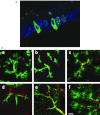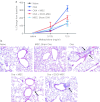Stem cells and regenerative medicine in lung biology and diseases
- PMID: 22395528
- PMCID: PMC3369292
- DOI: 10.1038/mt.2012.37
Stem cells and regenerative medicine in lung biology and diseases
Abstract
A number of novel approaches for repair and regeneration of injured lung have developed over the past several years. These include a better understanding of endogenous stem and progenitor cells in the lung that can function in reparative capacity as well as extensive exploration of the potential efficacy of administering exogenous stem or progenitor cells to function in lung repair. Recent advances in ex vivo lung engineering have also been increasingly applied to the lung. The current status of these approaches as well as initial clinical trials of cell therapies for lung diseases are reviewed below.
Figures





Comment in
-
The challenge of using gene- or cell-based therapies to treat lung disease.Mol Ther. 2012 Jun;20(6):1077-8. doi: 10.1038/mt.2012.91. Mol Ther. 2012. PMID: 22652992 Free PMC article. No abstract available.
References
Publication types
MeSH terms
LinkOut - more resources
Full Text Sources
Other Literature Sources
Medical
Miscellaneous

